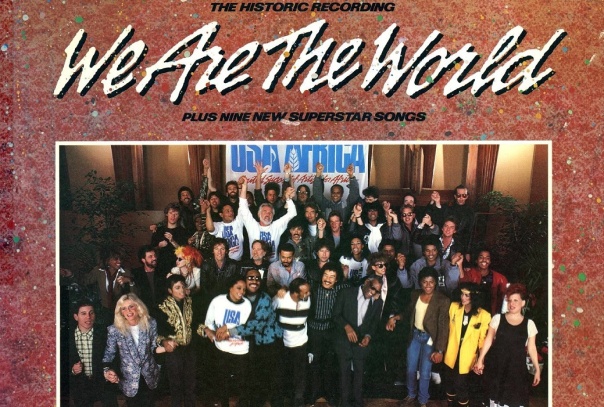As I’ve mentioned before, I’m a historian. Like an actual, two degrees in the subject, works at a museum historian. And I seriously never know what will come up in a given day at the museum. Once I had someone call to ask me what the phone number for the police was before 911 because he was restoring a vintage police car and wanted to put the original number on it. Once I spent an afternoon watching Nazi propaganda footage. Yesterday I spent time going over satellite images of a prison yard looking for an old cemetery. It’s always old, but it never gets boring…
So when I was thinking about a new topic to bring to Food Shelf Friday, I quickly thought of history. I love all the where did this come from and whatever happened to… Right away I thought of a hunger issue from my childhood – the 1980s famine in Africa and the celebrity fundraising response.
Check out this gem – We Are the World by USA for Africa, 1985. Just take the seven minutes and giggle at the ‘80s fashions, try to identify all the celebrities, and get this song firmly lodged in your head for the day (sorry not sorry).
Do you remember it? I do! I remember singing that song in school music class and seeing the video on TV. The famine in Ethiopia was all over the news from 1983-85. It was the worst famine in that region in a century, caused by drought and coupled with civil war and human rights violations, it resulted in hundreds of thousands of deaths. When the Ethiopian government failed to adequately respond to the crisis, international aid organizations and foreign governments began to pour into the region with funds, supplies, and aid workers to try and alleviate the crisis.
In 1984, after seeing a BBC story on the famine, a group of British and Irish musicians got together under the name Band Aid to record a song to raise money for the crisis. Do They Know it’s Christmas hit the airwaves in December of 1984 and raised millions for dollars for the cause.
Inspired by the Brits, a group of American musicians calling themselves USA (United Support of Artists) for Africa, recorded their own single, We Are the World (hyperlinked again because I KNOW you want to watch it again…). The song was released in March of 1985, and it also brought in millions of dollars.
Inspired by their success, the musicians decided to keep the momentum going and planned a huge, world-wide concert and telethon event called Live Aid. On July 13, 1985, concerts were held simultaneously in Philadelphia and London, while other performances went on in countries across the globe. Pulling it off involved satellite feeds, multiple media organizations, venues, performers – barely controlled chaos! But the publicity and fundraising stunt worked in spite of the big egos and technical chaos. Between the initial event, and the books and recordings sold later, Live Aid eventually raised over $125 million for famine relief in Africa. It also inspired musicians to hold similar events for other causes, including Farm Aid for American farmers losing their family farms, and Live 8 for global poverty relief.
I hope you enjoyed this blast from the past! Follow the hyperlinks to check out YouTube videos, org websites (yes, some of them are still around and raising money for today’s crises), and a History Channel article. If you love the celebrity gossip stuff, check out the Wikipedia pages, especially for Live Aid. Wikipedia isn’t the most reliable source, so I didn’t include it here, but if you want all the dirt and gossip of who was invited to perform, who was left out, who failed to show up, and who dropped the f-bomb on live TV, Wikipedia has all that. Share your memories of these star-studded relief efforts in the comments!



